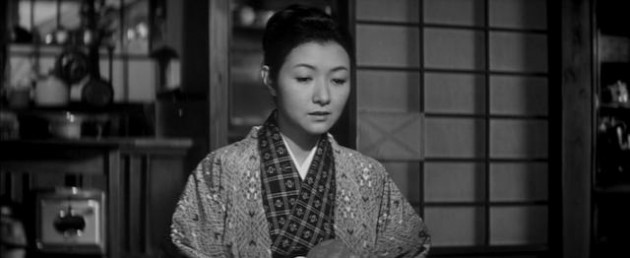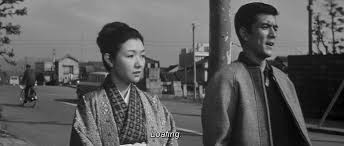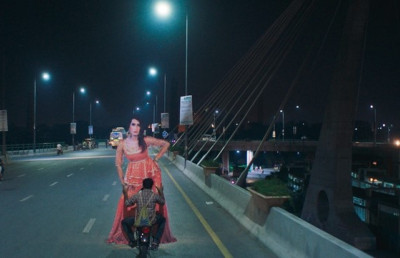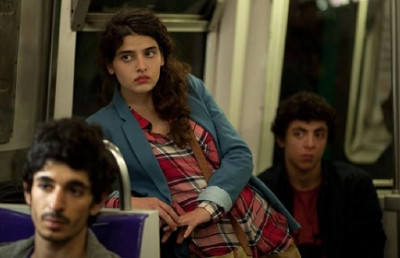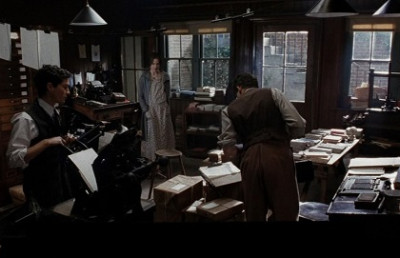To the Bitter End: Looking Back at Mikio Naruse’s Doomed Romances
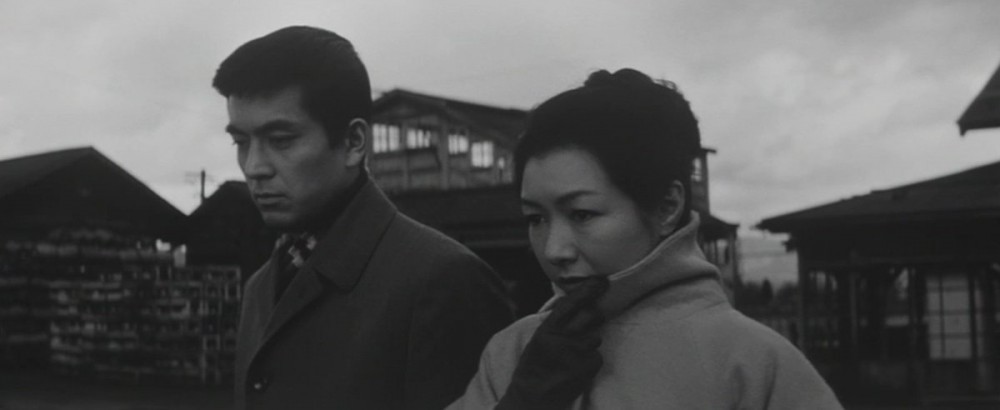
During his thirty-seven-year career (1930-1967), veteran Japanese director Mikio Naruse (1905–1969) directed eighty-nine films. Of these, sixty-seven survive. Naruse tended to work within the Japanese film genre known in Japan as Shōshimin eiga (“home drama of everyday folk”), contemporary stories which typically dramatized the lives of the lower middle class (often also called Shomin-geki by Western scholars). He achieved commercial success early in his life with his silent films Flunky, Work Hard (1931) and Wife! Be Like a Rose (1935). His post-War films were equally popular with Japanese audiences. Film critic Dave Kehr writes that “Mikio Naruse belongs with Ozu and Mizoguchi in the great classical tradition of Japanese cinema, though he remains almost unknown to American audiences.”
Donald Richie believed that even though the West was unaware of Naruse’s work, Japan had not forgotten him, arguing that “His reputation was never lost in Japan. The Japanese know perfectly well who Naruse is” (Thomson). He is often compared with his colleague, Yasujirō Ozu (1903–1963). Even his boss at Shochiku Studios, Shiro Kido, once told him, “We’ve already got an Ozu.” Possibly because of this, Naruse left Shochiku in 1933 for PCL (which soon became Toho), where he remained for the rest of his career. While both directors shared similar techniques, such as minimal camera movement, they were very different filmmakers. Japanese film critic and researcher Shigehiko Hasumi (2016) observes that “Naruse’s miraculous use of second-story windows, the supple interpenetration of the exterior and interior begs a comparison with Hitchcockian space, and the intricate play of the backlighting and front lighting falling across a face evinces Naruse’s affiliation with Griffith’s legacy.” Ozu dealt with families in his films, but his approach differed from that of Naruse. The protagonists in Ozu’s bittersweet films often calmly accept the trials of life, most famously in Tokyo Story (1953), where a retired couple are disappointed when their children avoid spending time with them during a brief visit. The parents nevertheless decide that they are in a much better position than most others when it comes to the matter of children, saying: “They are certainly better than average. We are fortunate.”
Naruse was of a different opinion where life was concerned. Orphaned at an early age, he had a difficult childhood. His films portray individuals locked in an eternal battle against a cruelly unjust life. He told stories of their fight against fate, against social prejudices, and often the hardships faced by women in post-World War II Japan. Characters in his films are often defeated, despite their desperate struggle against life’s myriad cruelties. Naruse once said, “If my characters move even a little, they quickly hit the wall. From the youngest age, I have thought that the world we live in betrays us; this thought still remains with me” (Jacoby). The theme of doomed romance recurs throughout Naruse’s films. His drama Floating Clouds (1955), an adaptation of a famous (in Japan) Fumiko Hayashi novel of the same title, is still one of his best known works internationally. Featuring a stellar performance by Hideko Takamine, it deals with an ill-fated romance that blossoms during World War II in Japan-occupied French Indochina and ends in the bleak landscape of post-War Japan. Naruse made four films in the last four years of his career, the most memorable being Yearning (1964) and Scattered Clouds (1967). Both inevitably share this leitmotif of ill-fated romance. The central female protagonists in both films are widows, strong characters who struggle in a still largely patriarchal society.
After the Second World War, under the leadership of General Douglas MacArthur, the Supreme Commander for the Allied Powers (SCAP), American forces occupied Japan from 1945 to 1952. Japan’s military and armament industry were dismantled, and the emperor’s status was lowered to that of a “figurehead.” Besides the political changes, the occupation administration introduced a slew of social, economic, and education reforms. There were new laws to improve the status of women; old family structures, including joint and multi-generational families, gradually evolved into nuclear families; traditional societal structures were questioned as American cultural influence increased, particularly with younger Japanese, amongst whom American music and movie idols became wildly popular. Japan was at a crucial juncture. There was a sharp increase in urban population; modern businesses started replacing more traditional and family-run ones; there was a rise in juvenile delinquency; while black markets and gang wars were commonplace. The rapid transition under the U.S. occupation from a traditional society to a modern one was not always smooth. Naruse’s films often portray how this transitional period affected individual members of a family. In particular, his female characters are generally the worst victims of the rigid codes that marked traditional Japanese society. They are encouraged by the new and modern ideals to be independent, but such independence comes at a great personal cost.
Naruse usually did not give his cast elaborate instructions; he wanted them to be natural. He preferred actors who were, according to veteran actor Tatsuya Nakadai, very “responsive.” Naruse believed that spontaneous, instinctive responses from his actors to a given situation gave his films a natural flair. His films were also subtle, and avoided melodramatic displays of emotion.
Yearning (Midareru) offers a portrait of Japan about eighteen years after the end of World War II. It is the story of a war widow, Reiko Morita (Hideko Takamine), who married young, living with her husband for just six months before he left to serve in the War. The husband never returned, and the audience only sees him as a treasured photograph. Reiko, a traditional woman, helps run her mother-in-law’s old-fashioned family grocery store. During the War, like much of Japan, her home was firebombed in an Allied raid. After the War, she helps restore the store from the ashes. One of Naruse’s central recurring themes is how widows were often treated unfairly by a social system that still clung to outdated ideas. Reiko’s brother-in-law, Koji Morita (Yûzô Kayama), is a good hearted but spoilt young man who spends his time gambling and drinking. Growing up in the shadow of a brother who sacrificed himself in the War was not easy for him. After the War, as the country rebuilt, the Japanese were encouraged to emulate the American model of a “modern society.” The rising popularity of national supermarket chains whose large stores sold merchandise at much lower prices were often the cause of the destruction of small, family-run businesses such as the little shop run by the Morita family. An example of the effect of this in the film is the suicide of a neighbour of the Moritas whose business goes bankrupt.
Naruse often shows the decaying of traditional moral values in his films. In Yearning, Koji is engaged in a physical relationship with a young “modern” girl who smokes in front of her elders and openly chats about casual flings. Meanwhile, to complicate matters, Koji is secretly in love with Reiko. He stands up for her rights when his family tries to keep her out of the loop when they try to sell the shop, which is to be replaced by a supermarket. The shadow of a supermarket, an emerging modern site of business transactions and a form of capitalist intervention in the traditional family-based small-scale business model, looms large in the film. This functions both as a symbol and as a dominant element in the fast-changing era of Japan’s “economic miracle.”
Koji’s errant lifestyle turns out to be because he is repressing his love for Reiko, which he knows is an impossible one. Takamine effectively plays Reiko as a character who is, like Koji, repressed and torn between happiness and despair. Reiko is lonely, but she knows traditional society will not accept a relationship between her and her dead husband’s brother. She is strong and independent, but she respects the traditional principles which imprison her and finds it impossible to transgress against her society’s strict mores. She rejects Koji’s advances even when he tries to impress her by changing his vagrant ways. The camera movement, although minimal, is used to express the dynamic between them. It follows Reiko and Koji whenever they walk together, perhaps from an outsider’s perspective. Reiko gradually walks ahead of Koji and out of the frame; he has to catch up when she turns around to look at him. He just cannot reach her. She spurs his advances every time. Towards the end, she walks away from the family business. Koji decides to follow her on the same train. A long scene follows where they appear to forget their real-life troubles and enjoy the overnight journey. When morning dawns, the illusion evaporates. At Reiko’s request they leave the train at a mountainous hot spring town. Reiko confesses, “When you said you loved me, I felt very glad.” However, this changes nothing. She cannot cross the boundary of social values. This eventually culminates in Koji’s death. His body is found the next day; the audience cannot be sure if he fell off the cliff or it was suicide. In the final scene, Reiko follows, staggering, as they carry his body down the path. She stops when the bearers must cross a bridge, perhaps the harsh truth of the situation finally sinking in. The final shot is a close-up. The audience is left wondering what her state of mind is – grief, disbelief, or acceptance. One may even wonder whether her earlier statement to Koji, “I didn’t waste my life. I lived it” may not have been true after all.
Although the script is credited to Zenzo Matsuyama, the story is Naruse’s own, and it is a characteristic tale of grief and suppressed desires. Reiko’s struggle to save herself and Koji from the scandal of an illicit love affair ultimately backfires. She loses what she loves the most. Women in Naruse’s films struggle against insurmountable odds, in this case an ungrateful family, post-War economic upheaval, and a society that looks down upon any kind of romance outside of marriage. The unhappy and confused state that results is reflected in the Japanese title Midareru, which means, depending on the context, something like “confused” or “disturbed.” In the end, this confusion steals whatever chance they had of happiness in their lonely and disturbed world.
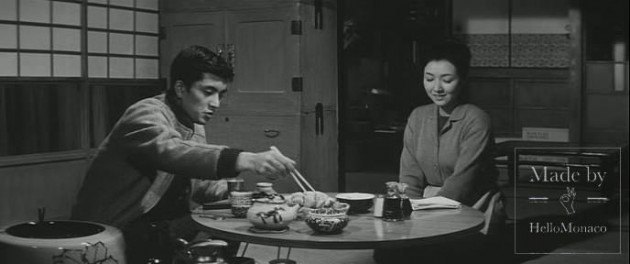
Yûzô Kayama and Hideko Takamine in Yearning
Michael Koresky (2011) once observed about Naruse’s films that “His stories are inhabited by people, generally women, imprisoned in their domestic and professional circumstances by the status quo, and hinge on tragic accidents and other twists of fate. But despite these dramatic trappings, his films are infused with a remarkable realism and pragmatism—they are not simply portraits of ordinary folks in extraordinary emotional situations but reflections of everyday life, with vivid material presence and indelible figures who remain outwardly serene even as battles rage within.” This statement is well illustrated by Naruse’s final work, Scattered Clouds (Midaregumo), also known as Two in the Shadow. In this film, Naruse tackles many of the same issues he deals with in Yearning and Floating Clouds. Like them, it is a moving study of the lives of two people and their fight against an inevitable, unhappy outcome.
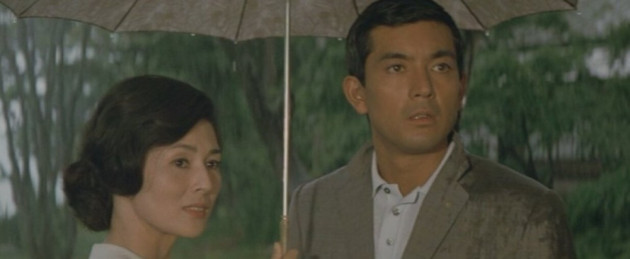
Yôko Tsukasa (Yumiko) and Yûzô Kayama (Shiro) in Scattered Clouds
Here the female protagonist is Yumiko, played by Yôko Tsukasa (an Ozu and Kurosawa veteran). She is a smart and urbane homemaker. Yoshio, Yumiko’s husband, is a corporate man, about to be transferred to Washington. The happy couple is seen making plans for the future, talking about their unborn child, and improving Yumiko’s English-speaking skills. True to a Naruse storyline, disaster strikes. Yumiko’s husband dies in a car accident. Naruse had used this plot element before, most recently in Hit and Run (1966). In The Cinema of Naruse Mikio: Women and Japanese Modernity, Catherine Russell writes: “Naruse depicts automobiles as a demonic machine of modernity, grinding the bodies of women, children, and the serving class in its gears and spitting them out as dead and damaged” (388). Tsukasa also played a key role in Hit and Run, as the lover of the man who runs over a child. In this film, her character is on the receiving end of a similar tragedy. The driver of the car is Shiro, played by Yûzô Kayama. Although the cause of the accident is mechanical, Naruse hints at Yoshio being drunk. This is not the only time Naruse has portrayed drinking as a destroyer of lives. For example, in Yearning, Koji was drunk on the night of his death. And like Reiko in that film, Yumiko is shattered. Naruse again returns to the problems faced by a widow in Japan. Although Yumiko sends her in-laws a part of the pension money she gets, they still choose to strike her name off the family registry, leaving her completely cut off from the pension fund. Her husband’s employers treat her no better. Even though Japanese society and laws underwent radical changes in the rebuilding phase, it still did not recognize the monumental challenges faced by a single mother or a widow. In Scattered Clouds, Yumiko probably opts for an abortion. This is left slightly ambiguous; even though one sees the interior of a hospital, it is not clearly shown what happens.
Shiro, even when pronounced innocent, feels guilty. He tries to apologize to Yumiko, but her grief prevents her from forgiving him. He nevertheless agrees to the demand from Amako (Yumiko’s sister) that he provide restitution to her for as long as he can. Yumiko is reluctant to accept it, but she has been left penniless. In the meantime, Shiro is unfairly transferred to Aomori, a distant city, by his boss, who has shifted the blame to Shiro for having an escort in the car with the company’s foreign guest at the time of the accident (Shiro had been directed by his boss to show his guest “a good time”). Shiro suspects that he is being reprimanded because he is dating the boss’s daughter, Junko. According to his boss, Shiro has neither the social position nor the financial stability of a prospective son-in-law. Naruse portrays the end of Shiro and Junko’s relationship in a sequence which begins with a shot of Junko waiting in Shiro’s home. Junko is unwilling to move to Aomori. Naruse moves from wide shots of Koji and Junko to close-ups that highlight their expressions. She closes the curtains, probably to have some privacy. Shiro is gentlemanly, but stern as he refuses her advances. The next shot switches to an outside perspective, showing Shiro opening the curtain silently. Naruse’s editing here is simple, yet affecting. He uses a close-up of Junko picking up her purse from a table, leaving behind Shiro’s home key, to signal the end of their relationship. Naruse employs fast cuts with great effect, using shots of inanimate objects, such as a key or a purse, to symbolize the silent tension present in the room. Kurosawa’s comment about Naruse’s style, “The flow is so magnificent that the splices are invisible . . . like a deep river with a quiet surface disguising a fast-raging current underneath” (113) is well illustrated here.
Meanwhile, losing her temporary job as a cashier/secretary in the city forces Yumiko to also consider moving to Aomori, her hometown. Yumiko’s sister Katsuko lives in Aomori, and she is also a widow. Katsuko runs a ryokan (a traditional Japanese inn) there, and unlike Yumiko’s genteel character, she is bold and assertive. Working in the same town, Yumiko and Shiro come across each other. Shiro has a gentlemanly demeanor, but at the same time is quite childlike in his behaviour. His feelings of guilt and empathy for Yumiko turn romantic. The final act of the film finds the protagonists gradually falling for each other, despite Yumiko’s own aversion to such a relationship. Her conviction is that Shiro was indeed at the wheel of the car that killed her husband. Much like in Yearning, the people in question face conflicting emotions, all the while thinking about the social repercussions of such a relationship. In Yearning, Reiko could not transgress traditional social values. However, in Scattered Clouds, Yumiko is less concerned about society than her own inner voice, and if she will ever be able to forget the tragedy of her husband’s death. Because of this inner voice, the relationship is doomed from the start. The two take a boat ride on a lake, during which Shiro develops a high fever. Stranded, they go to an inn. Reminiscent of the final acts of Naruse’s Floating Clouds, which has a remarkably similar setting, the night passes amidst a thunder storm and torrential rain. Shiro recovers the next morning, but their relationship doesn’t.
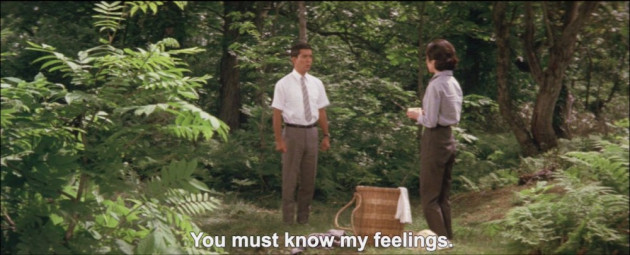
Yûzô Kayama and Yôko Tsukasa in Scattered Clouds
In one scene, Naruse portrays the couples’ inner conflicts by framing them in wide two shots, apart from each other, against the lush green backdrop of Aomori’s countryside. They look alone, and almost fragile. Close-up shots are once again used to highlight emotions, and, in a moment of passion, kissing. Naruse, in his final film, is bolder than usual. He mostly avoided direct depictions of passion, preferring to rely on body language and suggestive editing. At this point in Scattered Clouds, the viewer may be tempted to think that this relationship has a chance of success. However, Shiro had previously requested a transfer from Aomori when he believed his presence caused Yumiko distress, and the transfer finally comes through. He is supposed to go to Lahore which, according to popular Japanese belief, is the birthplace of cholera. The two decide to rent a ryokan. The next sequence takes place in a car, and is marked by the absence of dialogue between the protagonists. At a railway crossing, the car pauses. In this lengthy scene, Naruse again uses two shots and close-ups, showing Yumiko and Shiro’s growing discomfort and the symbolic red warning signal of the railway, as the train seems to rattle on endlessly. Toru Takemitsu’s music heightens the mood, leading up to a moment where they pass the crushed remains of two cars. The penultimate scene is almost silent, consisting of shots devoid of any music. The couple’s longing is expressed through lingering over-the-shoulder shots and the close-up of a final kiss. The silence, and the illusion of any sort of possibility of a romance, is shattered by an ambulance siren. The music resumes when the ambulance finally arrives to take away the victim of the accident. In the first act of the film, when Yumiko goes to the hospital to identify the body of her husband, his head was swathed in bandages. The appearance of the accident victim in the final act is almost the same. Wordlessly, Yumiko and Shiro both realize the futility of their romance. The film ends with Shiro leaving on a train, while Yumiko strolls beside a beautiful lake, her movements during her sad walk expressing her resignation. Even the film’s vibrant colours and lush scenes of Aomori somehow express a sadness that permeates the whole story. Naruse’s final film is ultimately yet another narrative where two people try to change the inevitable and fail. It expresses longing and helplessness in subtle ways. The alternative translation of the title, Two in the Shadow, is also appropriate. Naruses’s editing, as usual, is very low-key. There are no overdramatic or unnecessary flourishes. Some scenes are entirely without dialogue. In an interview, Tatsuya Nakadai once said that Naruse’s advice to him was to be “natural,” saying: “I’ll convey everything through the editing.” His final film is a testament to that comment.
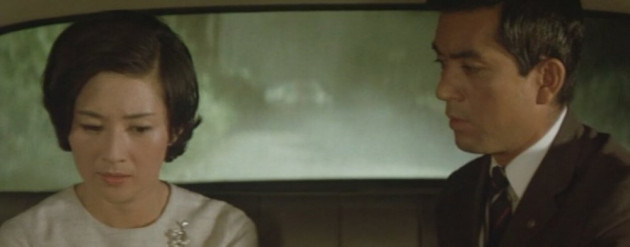
Yôko Tsukasa (Yumiko) and Yûzô Kayama in Scattered Clouds
Naruse was a master at capturing shifting emotions. Taiwanese filmmaker Hou Hsiao-hsien (2015) asserts in an interview that “As a director, Naruse has the ability somehow to depict how human emotions in a relationship change because of society . . . with the sense of hopelessness. And these characters are portrayed so delicately and movingly on-screen.” Scattered Clouds is also a reflection of the director’s knowledge of his own rapidly approaching end. Throughout his life, especially in the post-War years, his films consistently portrayed human beings engaged in an eternal battle in which there was never a “happy ending.” Fate always won. Philip Lopate, an American film critic, suggested perhaps the ideal way of understanding this point of view, writing: “Naruse’s forlorn flavor of existence can become addictive . . . One of the charms of Naruse’s art is its earned pessimism. It takes for granted that life is unhappy; therefore, we can relax in the possession of sadness, acquiesce from the start to the fate of disenchantment” (Rosenbaum).
Works Cited
Hasumi, Shigehiko. “Countering Errors in the Age of Discovery: On the International Critical Assessment of Mikio Naruse.” LOLA (2016). Web. 5 December 2020. http://www.lolajournal.com/7/hasumi_naruse.html
Hsiao-hsien, Hou. Hou Hsiao-hsien on the Films That Changed His Life Hillary Weston. Trans. Vincent Tzu-Wen Cheng. 20 October 2015. Web. https://www.criterion.com/current/posts/3754-hou-hsiao-hsien-on-the-films-that-changed-his-life
Kehr, Dave. Floating Clouds. n.d. Web. 5 December 2020. https://www.chicagoreader.com/chicago/floating-clouds/Film?oid=1059254
Koresky, Michael. Eclipse Series 26: Silent Naruse. 21 March 2011. Web. 5 December 2020. https://www.criterion.com/current/posts/1787-eclipse-series-26-silent-naruse
Kurosawa, Akira. Something Like an Autobiography. New York: Vintage Books, 1982. Print.
Nakadai, Tatsuya. Tatsuya Nakadai on Five Japanese Masters Aaron Gerow. April 2017. Web. 05 December 2020. https://www.youtube.com/watch?=YVvx9jQ5FcM
Rosenbaum, Jonathan. Geishas Without Diaries. 26 March 2018. Web. 05 December 2020. https://www.jonathanrosenbaum.net/2018/03/geishas-without-diaries
Russell, Catherine. The Cinema of Naruse Mikio: Women and Japanese Modernity. Durham and London: Duke University Press, 2008. Print.
Thomson, Desson. Director Mikio Naruse, A Name Finally in Lights. 10 March 2006. Web. 5 December 2020. https://www.washingtonpost.com/archive/lifestyle/2006/03/10/director-mikio-naruse-a-name-finally-in-lights/1dfa815d-6d5a-4b9e-987c-b08d76d0f8ef/
Tokyo Story. Dir. Yasujirō Ozu. Perf. Chieko Higashiyama. 1953.
Yearning. Dir. Mikio Naruse. Perf. Hideko Takamine. 1964.

